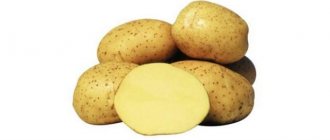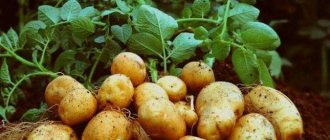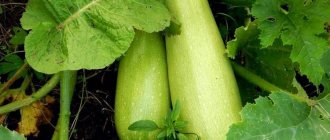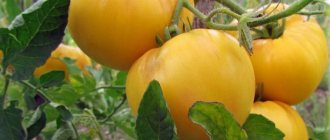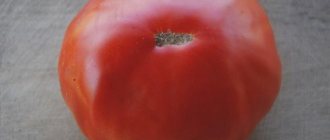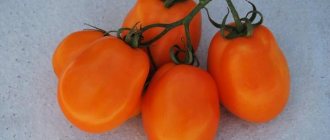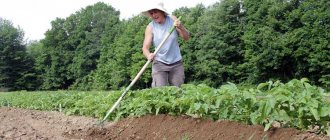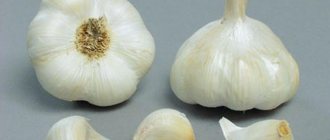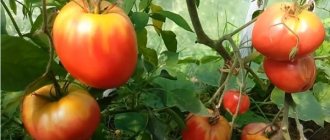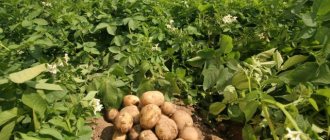Jelly potatoes – variety description, photos, reviews
Jelly potatoes are table varieties. It was created in Germany, in. In 2005, 4 years after submitting the application for registration, the variety was included in the State Register of the Russian Federation. Positioned in two regions: Central and Volgo-Vyatka. Today, Jelly is a huge success in the Russian Federation, Ukraine and Belarus.
The article will provide a description of the variety, photos and reviews of summer residents who have already managed to grow Jelly on their site.
Tuber characteristics
Jelly potatoes belong to the mid-early table varieties. It takes 90-110 days for tubers to fully ripen.
Potatoes are famous among commercial representatives due to the fact that they allow you to get about 550 centners from 1 hectare of planting.
Tubers are medium-sized, from 80 to 110 g. Larger specimens up to 140 g are found. On average, one bush produces about 12-15 potatoes.
The variety is crumbly. About 14-18% of Jelly's composition is starch. The color of the root shell is yellow. The color of the pulp is dark yellow. The pulp does not tend to darken when cooked.
The shelf life indicators are among the worst that can be found in the potato industry. Jelly does not store well, with a preservation rate of 86%, which is significantly lower than competitor varieties, whose preservation reaches 98-99%.
Storage
The Jelly potato variety stores very well (up to 86% of potatoes do not lose their marketable properties and taste), the marketability level reaches 95%. It is quite high-yielding - from 150 to 290 centners per hectare. In the Tula region, a kind of record was even registered - as much as 335 centners of the crop were harvested from a hectare planted with Jelly potatoes.
It is advisable to store it in dry, ventilated areas equipped with temperature and humidity controllers. Of course, it is mainly large agricultural enterprises that can afford to create such conditions. For your home, you can purchase a regular room thermometer to monitor the temperature, and evaluate the degree of humidity using an organoleptic method (palpation). The recommended storage temperature should be from +1 to +3 degrees.
It is advisable to cool the potato tubers before storing them for winter. The cooling process should be carried out gradually, by about half a degree per day. In the spring, when the ambient temperature invariably rises, night and morning ventilation is recommended to prevent tuber germination.
Advantages and disadvantages of Jelly
Over many years of cultivation, agronomists have identified a number of advantages of this variety. In particular, these include:
- Drought resistance. Jelly is not afraid of the scorching sun and can go without watering for a long time. Thanks to this, this variety can be grown in arid regions.
- Unpretentiousness. Potatoes will grow in almost any type of soil. Naturally, in good soil and with proper care, yields will be higher, but even in heavy soil Jelly will not show poor results.
- Transportability. Potatoes have a thick skin that protects them from mechanical damage when transported over long distances.
- Excellent presentation. Due to the beauty of the tubers, they are easy to sell on the market.
- Versatility. Jelly is suitable for making French fries, soups, and frying.
- Stability. Many varieties are degenerating. The same cannot be said about Jelly. The resulting harvest can be used as planting material from year to year without fear of a drop in yield indicators.
There are few disadvantages:
- Weak resistance to late blight. Moreover, not only tubers are affected, but also the plant part of the crop.
- Crop rotation. When growing Jelly, you need to systematically (every 3 years) plant it in another area. Otherwise, productivity indicators decrease.
Description of the variety
Jelly is a mid-early potato variety, selected by the German company Europlant Pflanzenzucht GMBH.
Entered into the State Register in 2005. First cultivated in the Central and Volga-Vyatka regions. It is unpretentious to soil and weather conditions, so it can be grown in absolutely any area.
The variety is grown quite safely both in industrial facilities and in private farms. Excellently retains its taste and appearance for a long time.
Correct fit
Planting of crops begins only after the soil has warmed up to +9-10 degrees Celsius. In warmer regions this occurs in early May, in colder regions in mid-May or early June.
You can also use the birch buds to guide you when potatoes are ready to plant. When they bloom, the soil is ready to “receive” potatoes.
Only the healthiest tubers are selected as planting material. They should not have any defects (cracks, stains, rot, bug holes). Experts also recommend treating root vegetables with special preparations against diseases.
When selecting seed material, you also need to pay attention to the size of the tubers. Ideally, these will be 70-80 g potatoes. Cutting potatoes is not recommended.
Planted according to the usual scheme:
- 70 cm between rows;
- 25-30 cm between bushes.
The planting depth in warm regions is approximately 10 cm. Closer to the north, the planting depth is increased by 5 cm, respectively, up to 15 cm.
Rules for preparing potatoes for seeds
To speed up the first harvest, root crops are germinated before planting in the ground. The selected seed material is removed from the cellar approximately 1–1.5 months before planting in the soil. The tubers are exposed to sunlight for 1 week. At this time, corned beef is formed in it, which contributes to resistance to diseases and pests.
After this, the potatoes are placed in shallow boxes or plastic containers and placed in a shaded, warm room for germination. After about 1 month, small sprouts 1–1.5 cm long appear in the potatoes.
Large tubers are cut into several parts before planting. In this case, you should pay attention that there is at least 1 sprout on each part. To prevent a putrefactive process from occurring after cutting the potatoes, they are kept for a week until coarsened tissue forms at the cut sites.
Rules of care
Caring for this crop is not difficult. It is enough to water, hill up, and fertilize the soil several times before planting.
Feeding Jelly
Potatoes do not need fertilizing as such. The only requirement is for the ground. It must be nutritious. To do this, in the fall, after harvesting, the soil is dug up and fed with humus.
In general, this feeding is quite enough to grow a good harvest.
In the same case, if the soil is heavy or poor in organic matter, even after fertilization, you can perform “direct” feeding, directly into the hole while planting the tuber.
Wood ash is used as fertilizer. If it is not there, humus will do.
Irrigation
Water the Jelly potatoes systematically. Experienced agronomists advise doing this according to the standard scheme:
- Do not water the potatoes until the tops emerge from the soil.
- The first watering should be carried out when the tops rise by 10-25 cm.
- Water the crop a second time at the moment the flowers form.
- Water the third time before the end of flowering.
Of course, if potatoes are grown in a particularly dry region where rainfall is rare, the amount of watering can be increased. But without fanaticism.
Also, so that potatoes have a lower risk of late blight, it is not recommended to water them after the flowers disappear from the tops.
Hilling
The most important agrotechnical procedure that allows:
- Saturate the soil with oxygen.
- Support the tops from adhering to the ground, thereby protecting them from untimely drying.
- Remove grass from the area.
Hill up the crop only 2 times. The first, when the tops have gained growth (20-25 cm). The second time approximately 15-20 days after the first procedure.
Features of cultivation
Jelly potatoes are not too demanding to care for. It prefers light fertile soils with a high sand content.
Jelly potatoes and the characteristics of the variety allow you to periodically change planting areas, alternating potatoes with phacelia, radishes or legumes.
Before planting, the soil is treated with a cultivator, carefully selecting forgotten tubers and plant remains from the ground.
Fertilizing is required : potassium sulfate, magnesium sulfate, superphosphate. On personal plots it is possible to add wood ash, preferably birch ash.
An excess of nitrogen fertilizers is undesirable; it lengthens the growing season, reducing yields. Potatoes are planted at a distance of about 35 cm, leaving row spacing of at least 75 cm.
For sowing, both whole tubers and their parts are used . This approach helps save valuable varietal potatoes. “Jellie” has a high germination rate, sprouts appear quickly, and tubers set very quickly.
The variety is drought-resistant; watering is needed only in particularly hot weather. In areas with temperate or cool climates, plantings do not need to be watered. A one-time feeding is recommended; potatoes are spudded 2-3 times per season.
The variety has a pronounced dormant period , which has a good effect on the preservation of tubers. After harvesting, the harvested crop is thoroughly dried on the edges or under a canopy.
In the process of growing potatoes, it is often necessary to use spraying with all kinds of chemicals for a variety of purposes. We bring to your attention detailed materials on why you need to use fungicides, herbicides and insecticides.
There are many ways to grow potatoes. On our website you will find a lot of interesting things on this topic. Read in detail about Dutch technologies, growing under straw, in bags, in barrels, in boxes.
Diseases and pests
Jelly potatoes have a stable immunity that protects them from problems such as:
- potato cancer;
- rhizoctoniasis;
- scab;
- golden nematode.
On the other hand, this immunity does not help the variety resist late blight. In the case of Jelly, the green part is more often affected than the roots.
The development of late blight can be prevented by preparing the soil (autumn digging) and selecting absolutely healthy planting tubers.
Also, a serious cause of this fungus is stagnation of moisture in the soil.
We recommend reading: “Description of the potato variety Lyubava”
If affected leaves are found, they should be immediately torn off and removed from the area. After this, it is necessary to treat the bushes with special insecticides such as Ridomil.
Among insects, the wireworm or Colorado potato beetle can become a problem.
Gardeners' opinion
The desire of amateur gardeners to improve agricultural techniques and increase the return on their work is obvious. Therefore, when choosing a variety for planting, reviews about the qualities of plants received directly from ordinary residents are usually carefully studied.
Reviews of Jelly potatoes are usually very positive and positive. For example, experienced gardeners on thematic forums talk about how Jelly amazed him with his productivity. All other things being equal, Jelly turned out to be the most productive in the garden among more than thirty varieties. Another gardener reports that although Jelly is tasty and beautiful, it does not tolerate damage from blows and cuts. The whole family enjoyed it almost all summer and fall. It is noted that Jelly is not as sensitive to damage as Vineta. Summer residents often describe the consumer properties of Jelly: average starchiness; It cooks well - soft, but not falling apart. You can also fry it. The taste seems to be ordinary. Of course, sometimes it is noted that there are varieties that are tastier. But we all have different tastes when it comes to potatoes.
Harvesting
Digging up ripened potatoes is carried out in dry weather so that the process of drying and laying the tubers for storage for the winter is carried out correctly. The harvest selected from the beds is dried in a dark barn for 2 weeks, and only then brought into the cellar. During sorting, suitable tubers are laid aside for seeds. Some farmers green the seed in the sun before bringing it into the cellar.
